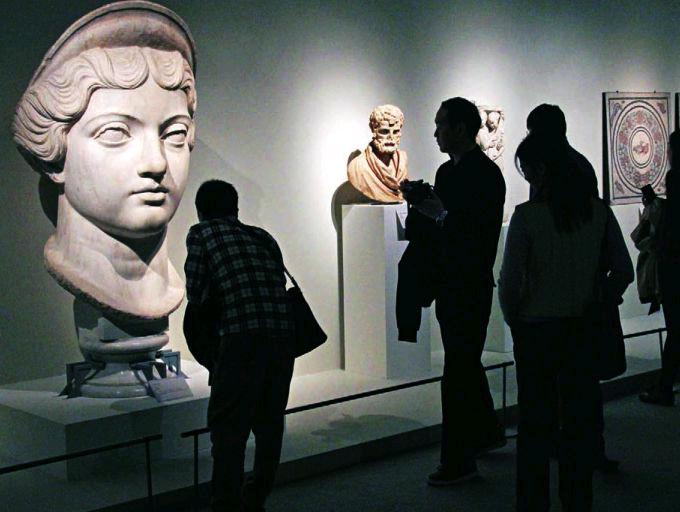A Cultural Journey Through European Civilization in Beijing
2014-03-03BystaffreporterJI
By+staff+reporter+JIAO+FENG
LI Sisi, a sophomore of the Central Academy of Fine Arts, cannot take her eyes off a bust of the Goddess Isis. She marvels at the perfection of the statue dated to 150-250, taking photos of it from different angles. On the other side of the exhibition hall at the National Museum of China (NMC) in central Beijing, a middle-aged couple is looking for the route of the Crusades on a map of the ancient Mediterranean. Such scenes replay every day at the “Mediterranean World from the Collections of the Musée du Louvre” exhibition on display at the NMC until February 9.
Another exhibition at the museum from the Princely Collections of Liechtenstein (running until February 15) also attracts a crowd. People quietly appreciate masterpieces of the greats, such as Peter Paul Rubens and Anthony van Dyck. A visitor from Shandong Province said, “It is a great pleasure to just stand here and see those pictures though I dont have a very clear understanding about world history.”
In recent years, cultural exchanges and dialogues have become an integral part of Sino-European relations. China and many European countries have held reciprocal years of culture, art exhibitions, concerts and other forms of cultural exchange activities. The fusion of Chinese and European cul- tures has brought both visual and auditory pleasure to people in China and Europe. In fact, culture has become the third largest pillar of Sino-European exchanges after politics and economy.
Mediterranean Civilization in Its Own Words
The Mediterranean region has seen the convergence of diversified cultures over centuries. Its complicated and multifaceted history of civilization has made an important contribution to the development of humanity and world civilization. The Mediterranean World from the Collections of the Musée du Louvre exhibition displays 280 pieces/sets of objects from the Louvre to showcase Mediterranean culture through the ages from a brand new angle.
According to Jean-Luc Martinez, head of the Louvre, his museum features cross-cultural art and houses the largest number of objects of Mediterranean culture in France. The exhibition this time presents over 2,000 years of history of the Mediterranean civilization.
The exhibition runs in chronological order, showing the development of civilization during important historical periods of the region: The civilizations of ancient Egypt – the Tigris and Euphrates rivers – laid a solid foundation for the Mediterranean civilization. After the 4th century BC, the civilizations of ancient Greece and ancient Rome rose to dominate the region. Around the 7th century, the Islamic civilization emerged and brought a fresh new style, and in the 14th century, the start of the Renaissance signaled modern civilization in Europe.
Martinez also pointed out that the exhibition marks the first time many objects have been displayed in China. Some artworks, such as a statue of Artemis – an ancient Roman cultural relic collected by the 18th century Scottish archaeologist Gavin Hamilton – is on loan from the Louvre for the first time.
A Sino-Franco First
The Mediterranean World from the Collec- tions of the Musée du Louvre exhibition is the first collaboration between the NMC and the Louvre. The NMC has previously held exhibitions on the Mediterranean region, including ancient Egypt, Greece and Rome. But what sets the current exhibition apart is that it displays, for the first time, the civilizations of the ancient Greek and Latin language families on the east and west coasts of the Mediterranean Sea, and the Islamic and Christian civilizations from the north and south of the Mediterranean Sea in their entirety. It thus presents a relatively complete picture of the rise and fall of different civilizations in this region.
According to Huang Zhenchun, deputy director of the NMC, one of the NMCs missions is to present the treasures of outstanding international culture. Over the past years, the NMC has cooperated with the British Museum and the Metropolitan Museum of Art to hold many exhibitions to promote international exchanges. The Mediterranean World, from the Collections of the Musée du Louvre exhibition, is a successful example of cooperation between large museums of China and France. It serves as a gift for the 50th anniversary of the establishment of diplomatic relations between France and China in 2014, and enriches the Chinese peoples cultural life.
Martinez said that the exhibition is the first step of cooperation between the Louvre and the NMC. He is happy that the exhibition serves as a prelude to celebrating 50 years of Sino-Franco diplomatic relations. He also said that as more and more Chinese people are now visiting the Louvre every year, he hopes to communicate with counterparts in China to help the Louvre better serve Chinese guests.
Pulling in the Crowds
I visited the Mediterranean World from the Collections of the Musée du Louvre exhibition on a weekday and observed many visitors, mostly young people, including students, and tourists. Li Sisi said that she likes Roman sculpture the best, because it is perfectly beautiful from any angle, and is of quality white marble that has retained its sublime texture and sheen over past centuries. She said that the exhibition helps her deepen her understanding of ancient European history and culture. “The scintillating history of the Mediterranean region coupled with self-revealing artworks is fascinating,” she commented.
A group of students from Beijing No. 2 Middle School visited the exhibition. While appreciating the charm of the artworks, they studied the history and development of the Mediterranean region with their art and history teachers. The teachers shared their comments and analysis on the exhibits and the students admitted that through visiting the exhibition they felt they had improved their artistic and cultural know-how.
A visitor from Xian, capital of Shaanxi Province, said, “The 100 or more objects displayed from the Princely Collections of Liechtenstein have high artistic value and backstories that can stimulate peoples minds. Through the exhibition, I can both appreciate the masterpieces of Western art and enjoy elegant, grand and romantic Baroque art up close.”
Arts not only nourish the soul with their beauty, but also help enhance mutual understanding and friendship among different cultures. Just as LüZhangshen, director of the NMC, said at the opening ceremony of the Mediterranean World from the Collections of the Musée du Louvre exhibition, the intermingling of different peoples and cultures in the Mediterranean region is a good example of peaceful coexistence and common development of countries with varying social systems and cultural backgrounds.C
